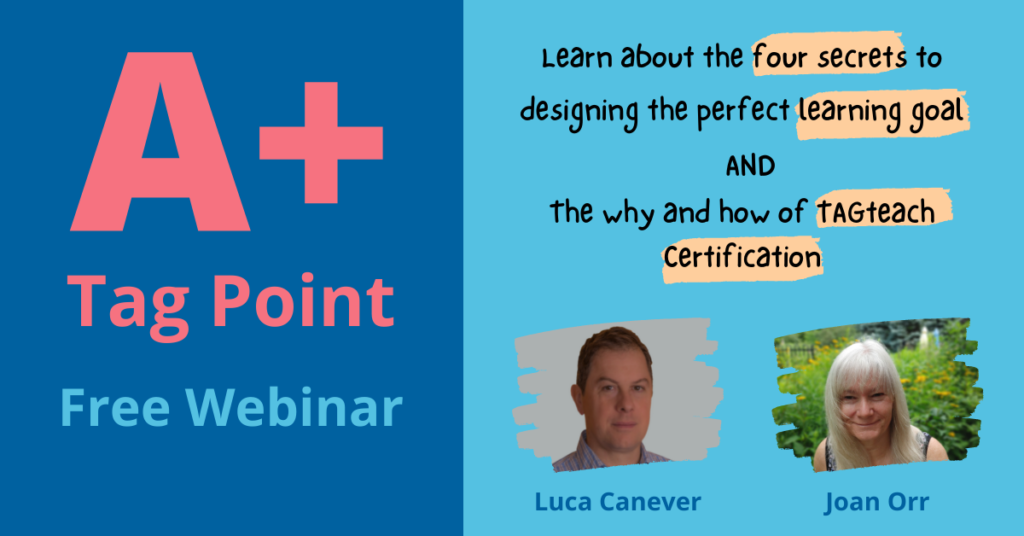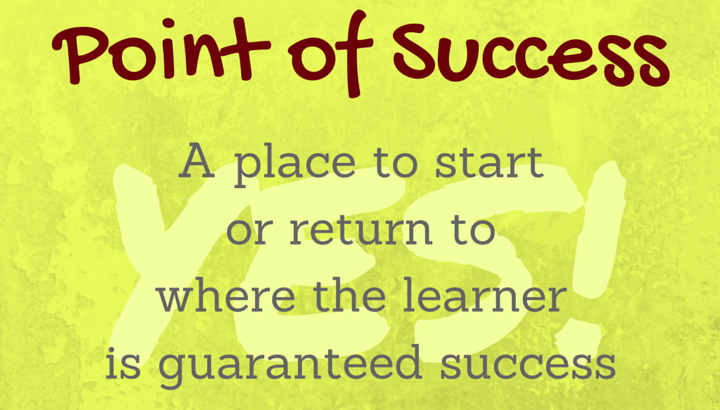Do you want your teaching to result in success the first time? Here’s how to do it: Set a learning goal that the learner can already do. It’s that simple. Start every new lesson with success and then keep building on this to get more success.
What is the Point of Success?
The point of success is something the learner can already do and where he is guaranteed to earn a tag. It’s the tag point that makes sure of an immediate win for the learner. For example a kindergarten student can most likely pick up a pencil with their writing hand. The first tag point in teaching letter formation could be “pencil in writing hand” if you’re sure your learner can do this. Starting with the point of success ensures success on the first try and provides a rewarding introduction to the lesson. The point of success will gradually change as the learner gains competency. The point of success is a place to return to if the learner is having trouble with more difficult tag points.
Finding the Point of Success
In some cases the point of success tag point is obvious. For example “arms at side” or “sit at the desk” are things that it is reasonable to expect that most learners are able to do at least for a moment or two. If you are a coach or teacher that has been working already with your learners you probably have a good idea of what each learner can easily do. With new learners or a new task, you need to evaluate their current status with the skill or behavior you are trying to teach. Ask them to attempt the skill and just observe without comment. Find something they are already doing correctly or something that is very easily accomplished and make this the first tag point.
For example in teaching a learner to play the piano the point of success may be to sit at the keyboard with middle C and belly button lined up. Perhaps this is too much for some learners and just sitting at the keyboard would be the point of success. If your learner doesn’t know where middle C is, then marking it with a sticker and using the tag point “point to sticker” could be the point of success.
Sometimes the point of success is more difficult to find. If you are teaching a complex skill and the learner seems to be doing many parts of it incorrectly or is missing a key aspect, finding a point of success may be more of a challenge. For example, you are teaching an athlete to high jump using the Fosbury flop method. This requires the back to be arched while clearing the bar, but the athlete is going over in more of a sitting position without the proper arch. Where is the point of success when the main component, the arch, is nowhere to be seen? In this case in order to find a point of success, you must make the task easier. Have the athlete lie on their stomach and push up with their hands while their hips remain on the ground. In this position it is easy for them to achieve the tag point “arch back”. They could also achieve this position lying on their back on the crash mat with either their upper or lower body hanging over the edge of the mat. Isolating an element from the skill in this manner allows the athlete to experience the feeling of the position and have it be solidified by hearing the tag without having to try to do all the other complex parts of the skill.
After a few repetitions of “arch back” isolated from the skill, move on to putting this back into the skill. To ensure the best chance of success, give the athlete as few other components to think about as possible. Remove the bar and ask them to jump from a standstill backwards onto the crash mat with the tag point “arch back”. This removes many other variables and gives the opportunity to put all their focus into the one key element. Gradually add one step toward the bar then two steps, then the full run and finally replace the bar. If the athlete begins having trouble, go back to the most recent point of success and build up again from there. Start each new session with a point of success identified from the previous session.
We recommend starting each new session at a point a couple of steps before the end of the last session. So you wouldn’t start a new session with the last thing they accomplished in the previous session, you would start with the second or third last step from the previous session.
An Example
Watch this video and see if you can see where the point of success is used.
Learn About the 4 Key Components of a Tag Point (Learning Goal)

